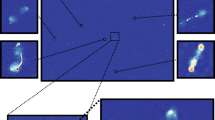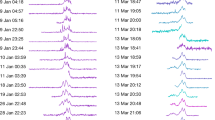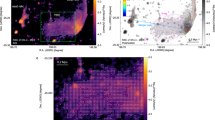Abstract
A typical extragalactic radio source is a simple double or elongated structure with a well-defined orientation on the sky. In 1972, Willson1 investigated the relative orientation of 74 extragalactic 3C radio sources mapped at the Cambridge 1-mile telescope, and noted that extended extragalactic radio sources tend to be parallel if they are separated by less than 10° on the sky. Since 1972, many more radio sources have been mapped with resolutions 10–20 times greater than that of the observations available to Willson. I have therefore reinvestigated this problem in two separate and largely independent samples of some 300 sources each, and report here that the alignment is present to a high significance level, provided that only the more distant sources are considered. The effect could be due to gravitational imaging if most of the matter in a closed universe is in thin filaments.
This is a preview of subscription content, access via your institution
Access options
Subscribe to this journal
Receive 51 print issues and online access
$199.00 per year
only $3.90 per issue
Buy this article
- Purchase on Springer Link
- Instant access to full article PDF
Prices may be subject to local taxes which are calculated during checkout
Similar content being viewed by others
References
Willson, M. A. G. Mon. Not. R. astr. Soc. 155, 275–282 (1972).
Laing, R. A., Riley, J. M. & Longair, M. S. Mon. Not. R. astr. Soc. 204, 151–187 (1983).
Pooley, G. G. & Henbest, S. N. Mon. Not. R. astr. Soc. 169, 477–526 (1974).
Riley, J. M. & Pooley, G. G. Mem. R. astr. Soc. 80, 105–137 (1975).
Jenkins, C. J., Pooley, G. G. & Riley, J. M. Mem. R. astr. Soc. 84, 61–99 (1977).
Laing, R. A. Mon. Not. R. astr. Soc. 194, 301–330 (1981).
Laing, R. A. Mon. Not. R. astr. Soc. 195, 261–324 (1981).
Hintzen, P., Ulvestad, J. & Owen, F. Astr. J. 88, 709–758 (1983).
Miley, G. & Hartsuijker, A. Astr. Astrophys. Suppl. 34, 129–163 (1983).
Owen, F., Porcas, R. & Neff, S. Astr. J. 83, 1009–1020 (1979).
Potash, R. & Wardle, J. Astr. J. 84, 707–717 (1979).
Siegel, S. Non-parametric Statistics (McGraw-Hill, New York, 1956)
Sanders, R. H., van Albada, T. S. & Oosterloo, T. Astrophys. J. (in the press).
Oort, J. H. A. Rev. Astr. Astrophys. 21, 373–428 (1983).
Author information
Authors and Affiliations
Rights and permissions
About this article
Cite this article
Sanders, R. Alignment of distant radio sources. Nature 309, 35–37 (1984). https://doi.org/10.1038/309035a0
Received:
Accepted:
Issue Date:
DOI: https://doi.org/10.1038/309035a0
This article is cited by
-
Marginal gravitational lenses of large separation: probing superclusters
Nature (1987)
-
The alignment of distant radio sources
Nature (1985)
-
Is the intergalactic magnetic field primordial?
Astrophysics and Space Science (1985)
Comments
By submitting a comment you agree to abide by our Terms and Community Guidelines. If you find something abusive or that does not comply with our terms or guidelines please flag it as inappropriate.



